From July 11–13, 2025, 290 attendees from across Africa and beyond gathered in Abuja, Nigeria, for EAGxNigeria 2025, the region’s largest EA conference to date.
Designed to support community growth, deepen cause engagement, and forge collaborations, this convening represented a key milestone in building an EA community that is locally grounded, globally connected, and strategically ambitious.
As part of the global EAGx series and supported by the Centre for Effective Altruism (CEA), our event featured engaging talks, workshops, networking sessions, and community-building activities. It received outstanding feedback from local and international participants and recorded a good number of the Giving What We Can (GWWC) pledge sign-ups.
| Key Information | ||
| Attendance | No. of applications received | 917 |
| No. of approved applications | 443 | |
| No. of attendees who registered on Swapcard | 372 | |
| No. of attendees | 290 | |
| No. of volunteers | 45 | |
| Budget | Total event grant | $73,350.9 |
| Actual expenditure (including staff costs) | $61,458.9 | |
| Travel support | $63,653.8 | |
| Cost per attendee | $431.4 | |
| Team Hours | Total team hours | 1692.35 |
| Content | No. of sessions (Talks, workshops, and meetups) | 29 |
Strategy and Objectives
EAGxNigeria 2025 was organized to catalyze the growth of Effective Altruism across Africa by connecting new and experienced community members, promoting thoughtful engagement with high-impact cause areas, and spotlighting regionally relevant paths to doing good better.
Objectives
- To bring together individuals who are thinking carefully about the world’s biggest problems or are working on solving them, to exchange ideas and knowledge
- To enable networking and relationship building among the attendees
- To amplify EA principles and ideas, and Impact-oriented actions
Admission
Admission strategy
The conference was for individuals who are familiar with effective altruism (EA) or who are actively applying EA principles in Nigeria, across Africa, and internationally, with a focus on:
- Members of the EA community in Nigeria.
- Nigerians who have engaged with EA ideas—such as completing 20+ hours of EA-related content (e.g., the Intro Fellowship, EA books, or programs) or working with EA-aligned organizations.
- Africans who are engaged with or connected to the EA community.
- International participants leading or supporting EA-aligned projects in Nigeria/Africa, or who could add value to conference sessions.
- Other international participants without direct ties to Nigeria/Africa, but who could meaningfully contribute to the conference’s success.
We initially set out to accept 200 persons for the conference but ended up admitting 443 due to the number and quality of applications. It is worthy of note that we had to increase the bar for admissions, and ended up rejecting over half of the applications, not because most of them were not good applications but because we had reached our event capacity.
There were a total of 295 attendees who attended the conference.
Attendees’ Location
We had applications from Nigeria, other African countries and countries outside of Africa. Here is a breakdown of applications we accepted by country:
- Nigeria - 325
- Kenya - 26
- Uganda - 18
- South Africa - 12
- Liberia - 5
- United States - 9
- United Kingdom - 6
- Other countries - 45
Visa Process for Attendees
We assisted some international attendees with their visa process by providing a visa support letter, and a guidance document for Nigerian visa applications, ensuring they had all the support they needed for their visa processing.
Outreach
We opened applications a little over 2 months before the conference date by posting on EA Nigeria social media pages (LinkedIn, Facebook, Instagram), EA Slack groups, WhatsApp groups, EA forum, our newsletters, and other channels. We got over 900 applications and did not need to run ads.
Attendees’ Experience
Who Attended?
- Students: Representing universities, medical schools, tech institutions, and youth-led initiatives
- Early & Mid-Career Professionals: Working in public health, research, AI, governance, government, nonprofit , policy e.t.c
- Community Builders: Representing EA university groups, national chapters, and cause-specific networks from across Africa
- International Guests: Including organizers and researchers offering global perspectives and mentorship
Event Tech
We used Salesforce to sort applications and send out decisions, and our main platform for coordinating the event with attendees was Swapcard, where they could book 1-1s, register for sessions, among other things. We also had Slack for attendees, volunteers, the organizing team, transport and accommodation, and related channels.
Production
We planned our production keeping in mind we may have more admissions, and later a little over twice our initial target of 200 participants were admitted to the conference.
Venue
Securing a venue for our conference was quite difficult due to the size and nature of the event. We considered these things among others: accessibility, facilities, and cost. We planned EAGxNigeria to hold for 3 days, including Sunday and most of the venues we were looking at had churches using their facilities on Sundays for service. We eventually narrowed down our choice to NAF Conference Centre and Suites after a few agreements were reached and contingencies sorted. This venue is easily accessible for attendees with a great number of hotels and facilities nearby.
NAF Conference Centre accommodated all attendees with their banquet hall being able to seat over 400 persons for speaker talks, 2 smaller halls for workshops and meetups by the banquet hall, a restaurant, and up to 5 other spots within the facility that we designated for 1-1s. They also had accommodations for the organizers and speakers. The venue was set up the night before our event, with some volunteers present to help on-site.
Logistics
We contracted vendors early enough; most of our vendors were sorted two months before the event date. There was a delay in getting the right vendor that could provide internet services for us due to varying options at that time, but this was sorted a few weeks before the conference. We made arrangements for a backup power supply that powered the LED screens, speakers, cameras, stage light, and feedback monitors to avoid disruptions during sessions. It was really helpful, and sessions ran smoothly except for a few times where we had some technical issues and about two times where there was a delay in speaker slides coming up. These issues were resolved as soon as they came up.
Food
The venue provided catering for us throughout our event, we worked with them early to design the menu because they did not have experience with vegan meals. They appreciated us for the learning experience. We had time to do some food tasting and leave them reviews before our event date.
We got reports early on in the conference that food was not enough for attendees, and too spicy at some point, we addressed these quickly with the management and there were improvements afterwards, we also got compliments from attendees on how great the meals were.
Content
Content Strategy
The Content Strategy prioritised two goals: fostering connections and increasing awareness to support action. Content emphasised local relevance with speakers from Nigeria and Africa, object-level cause-area focus, accessibility given that a significant portion of the audience was relatively new to EA, and supporting action through concrete next steps.
Speaker selection began early, about 3 months to the event, we prioritised value to attendees, regional expertise, and representation of cause areas.
The program consisted of:
- 16 Talks with Q&As, 3 Workshops, 2 Lightning Talks, and 21 Office Hours sessions.
- 8 Meetups and 11+ Unofficial Satellite Events.
- Opportunity Fair (14 exhibitors) and Opportunity Board (20 opportunities).
- Several meetup points and 422 confirmed 1-1s.
What Went Well
- Diverse content covering Global Health & Development, Animal Welfare, AI Safety, Biosecurity, Nuclear Security, and cross-cutting skills like research.
- Locally relevant content with sessions addressing cause areas and paths to impact that are important in the region.
- High satisfaction with content variety and regional relevance based on attendee feedback, as well as high attendance and engagement, with strong turnout and active participation across sessions.
- Strengthened networks: Survey respondents made an average of 10.86 connections, with 5.84 of those considered to be impactful connections. 208 attendees confirmed at least one 1-1 meeting, with participants connecting with at least one person. There was strong bonding among attendees, especially during networking and group sessions.
- Participants found 1-1s most valuable, followed by talks, workshops, meetups, office hours, and speed meetings.
- Opportunity Board generated significant engagement with 869 unique views and 249 bookmarks.
- Opportunity Fair was well-attended, with 14 exhibitors from 30 expressions of interest and 173 participant sign-ups.
- Attendees indicated a strong interest to take action as a result of the event.
- Leveraged local expertise, with all speakers engaged in regionally relevant work, and the majority coming from the region.
- Systematic speaker sourcing and selection, resulting in quality speakers and several first-time speakers presenting.
- Gender balance: ≈46% of both speakers and hosts were not cis men.
- Speakers generally had a positive experience, with a likelihood-to-recommend score of 9.48.
Which actions do you intend to take as a result of the event?
| No. of people | Intend to take a particular action as a result of the summit
|
| 89 | Apply for a short-term (<1 year) opportunity (e.g., fellowship, course, summer programme, or internship) |
| 53 | Apply for a full-time role |
| 77 | Apply for a grant, funding, or a scholarship |
| 37 | Accept an offer or start a short-term opportunity |
| 39 | Accept an offer or start a full-time role |
| 43 | Found a new EA or cause area group |
| 39 | Found a new EA-aligned project |
| 28 | Found a new organisation |
| 10 | Hire someone for a short-term opportunity |
| 9 | Identify someone you want to give a grant, funding, or a scholarship |
| 5 | Hire someone for a full-time role |
| 60 | Find a new collaborator, client, or partner on a project |
| 42 | Publish research or writing |
| 5 | Donate >$1,000 to an EA-aligned organisation or fund |
| 18 | Take the Giving What We Can pledge |
| 14 | Commit to donating >10% of your income to EA-aligned causes |
| 4 | None of the above |
- Giving What We Can pledge: Our event got 4 new 10% Pledges and 14 new Trial Pledges, 15 survey respondents who did not pledge reported that they decided to give more as a result of the Pledge Booth.
Volunteer Coordination
To run the event, we needed volunteers to help us coordinate it. We initially, in the conference application asked those interested in volunteering to indicate their interest. After admission and review, we had an incredible team of 45 volunteers, spread across key functions:
- Room Management
- Logistics
- Speaker Liaison
- Reception and
- First Aid/Medical Support.
To ensure smoother operations and manage the workload efficiently, we divided most of the teams into sub-teams operating in shifts except the Speaker Liaison and First Aid teams, who operated as standalone units due to their specialized roles. Each team played an indispensable role in creating a seamless experience for our attendees, but the journey to success was far from linear.
Training Volunteers
A week before the event, we held a virtual training session to align on expectations and protocols. However, post-training feedback revealed that some volunteers felt overwhelmed by the 16-page handbook’s density. To address this, we sent a follow-up email with a step-by-step guide. After the first day of the event, it was noticeable that some volunteers were falling short of their duties. Recognizing this, the volunteers coordinator decided to implement a daily morning stand-up meeting with all volunteers before the event kickoff. These stand-ups became an invaluable touchpoint to reiterate critical responsibilities, address concerns, answer questions, and foster a shared sense of purpose and collective growth. Likewise, before the end of the events, most of our volunteers deployed the Watch Team Back Up (WTBU) mindset, stepping outside their formal roles to address issues, contributing significantly to the recorded success of our event.
Throughout the event, our volunteer first aid team recorded and handled 16 first aid incidents, ranging from minor health complaints to the need for on-the-spot medication (mostly minor ailments like headaches and fatigue). We also recorded one loss of an item throughout the event, which is untraceable
Challenges and Key Lessons
- Printing: There were instances of missing or unprinted name badges due to the rush during the process. This issue mainly affected the late admission batch because our printing service couldn't catch up. We would do printing earlier to avoid this happening.
- Signage and Navigation: Some attendees initially found it challenging to navigate the venue despite the provided directions and facility sketch integrated into Swapcard. Simplifying wayfinding with clearer maps and on-site guides could likely improve future navigation.
- Reserve speakers: Timelines for organising lightning talks, meetups, and replacement speakers were short. Increased engagement of potential speakers who may not make it to the conference and initiating the content planning earlier in the event organisation would likely improve this.
- Content segmentation: One workshop appeared to be too introductory for the audience, suggesting the need for better content segmentation.
- Volunteer performance: Inconsistent execution by Speaker Liaison Volunteers, including skipping Q&A sessions and providing low-quality backup questions. Earlier selection and briefing of speaker liaisons would likely improve Speaker Liaison Volunteer readiness.
- Technical challenges: Screen malfunctions disrupted one session and caused a 40-minute delay in the schedule; mic failures resulted in one talk not being properly recorded; delayed slide setup resulted in at least two speakers beginning their sessions without slides displayed. Stronger venue technical partnerships, equipment backup systems, and oversight would reduce the likelihood of such challenges.
- Swapcard use: Attendees underutilized Swapcard for session reminders they had signed up for. Continued exposure and practice with Swapcard, and better dissemination of guidance on how to make the most of Swapcard, will likely increase usage over time.
Gaps in volunteer training: Day 1 revealed unclear task ownership and weak cohesion among the volunteers. We think, among others that this is due to a lack of training/testing them for real-time, high-pressure situations. Integrating volunteer morning check-ins, scenario-based drills in pre-event training could be essential for alignment, smooth execution, and strengthening readiness.
Further Links
Core Team
The EAGxNigeria core team comprises of:
Zakariyau Yusuf: Stewardship
Daniel Elabi: Team Lead
Mubarak Adebayo: Admission and Communication
Estelle Florens: Content Lead
Ilunamien Aisedon: Production
Chidi Odinanwa: Volunteer coordinator
The core team made significant contributions to the initial draft of this report, with Daniel leading the effort in editing and compiling it for distribution to a wider audience. Any recorded errors can be attributed to Daniel's oversight.

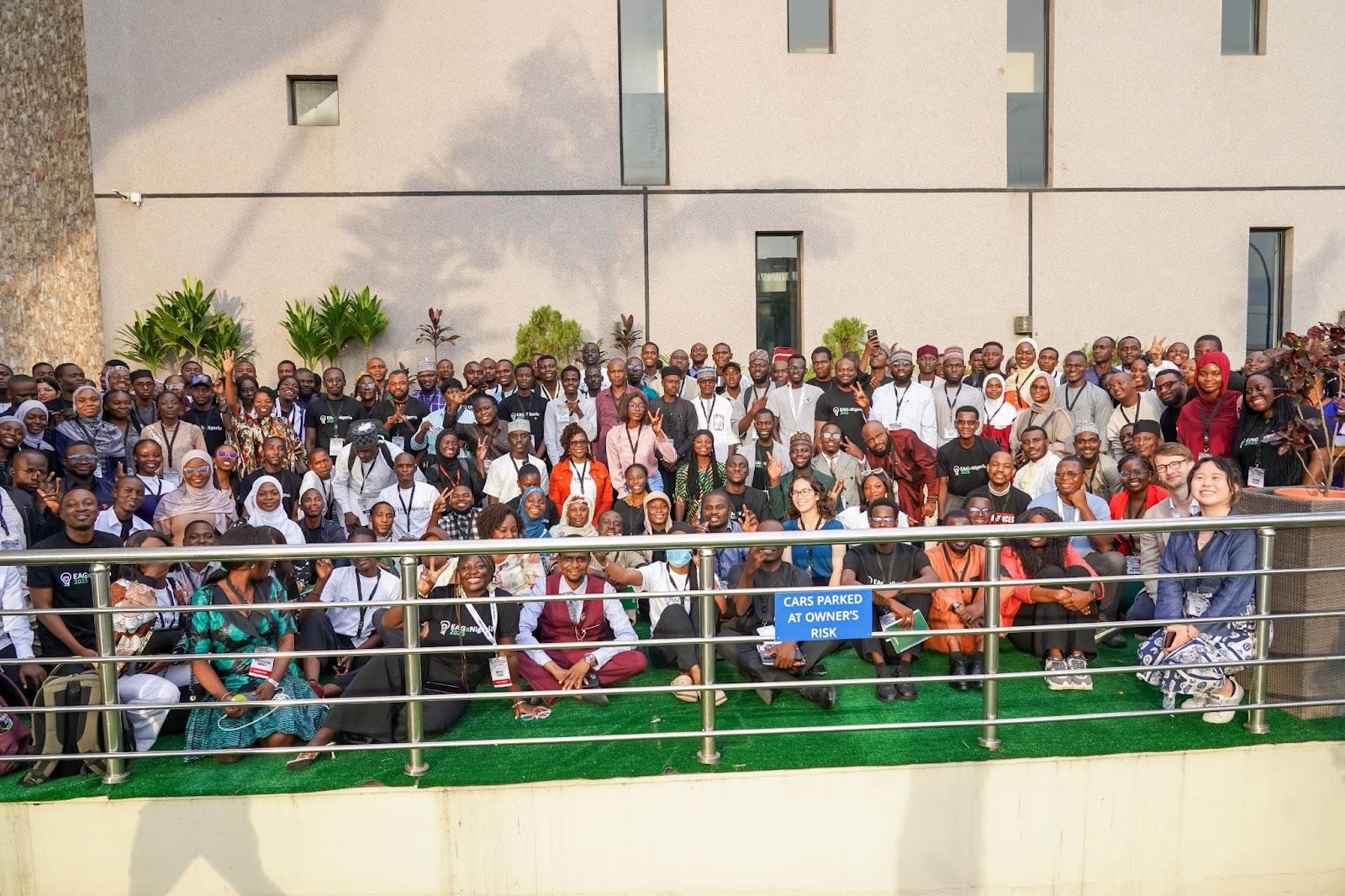
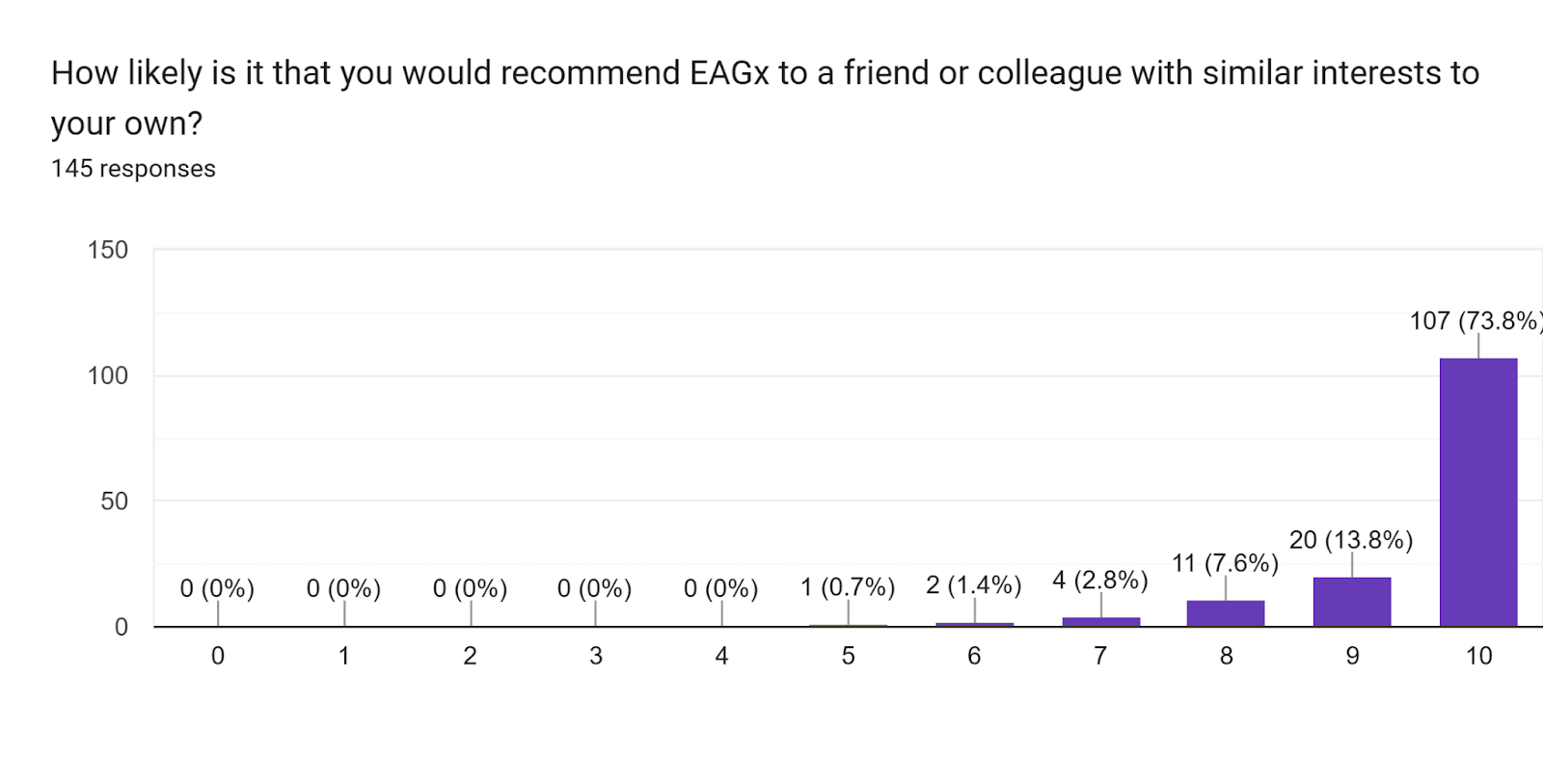


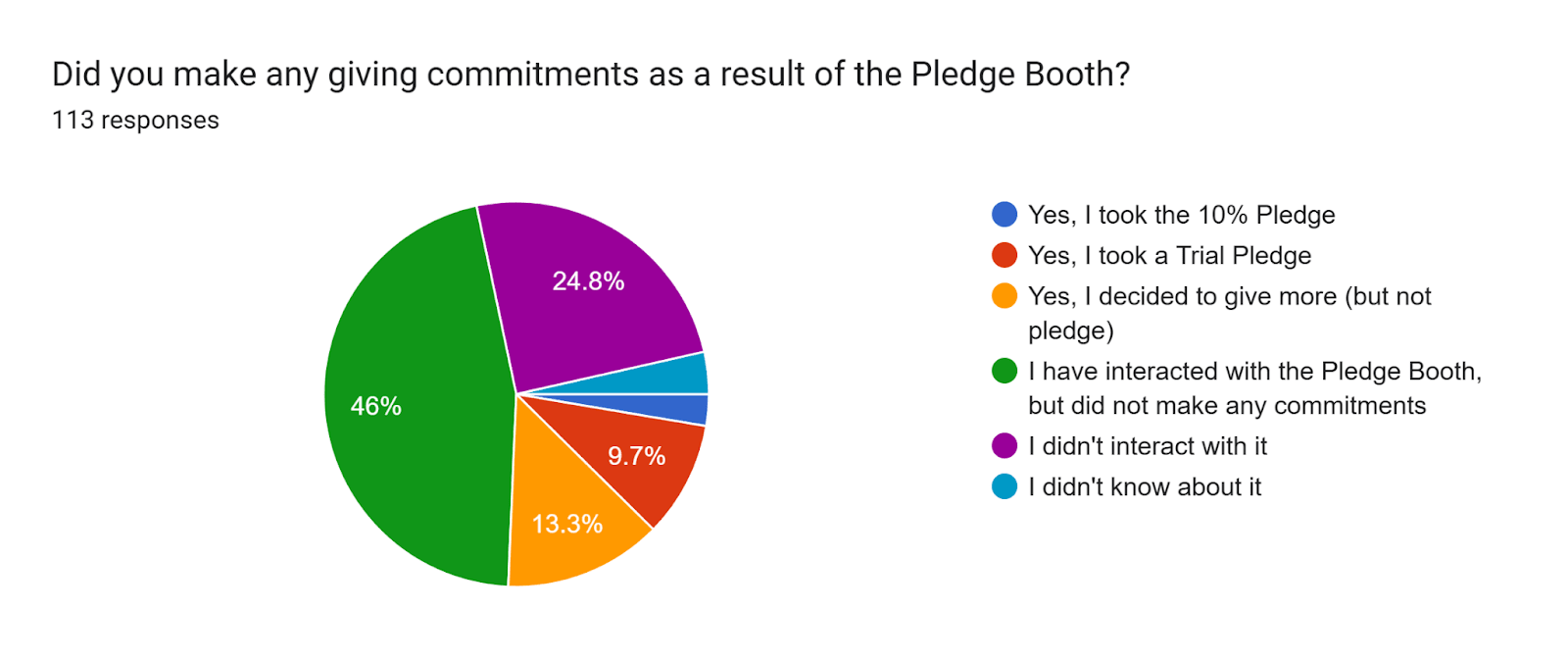
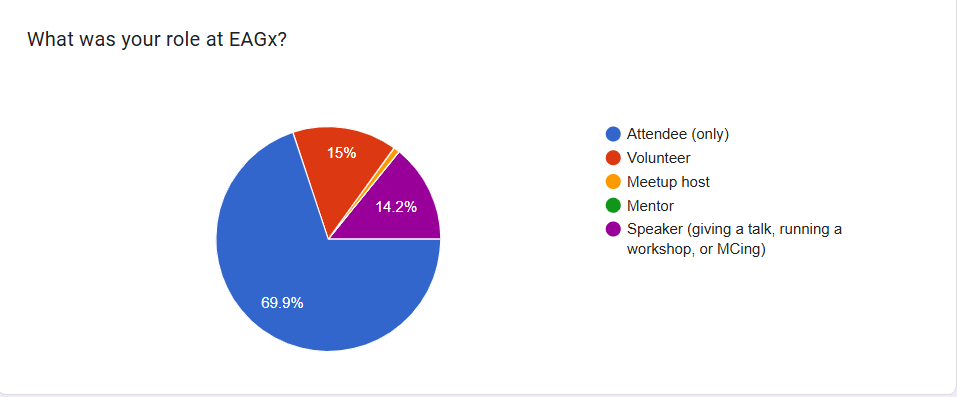
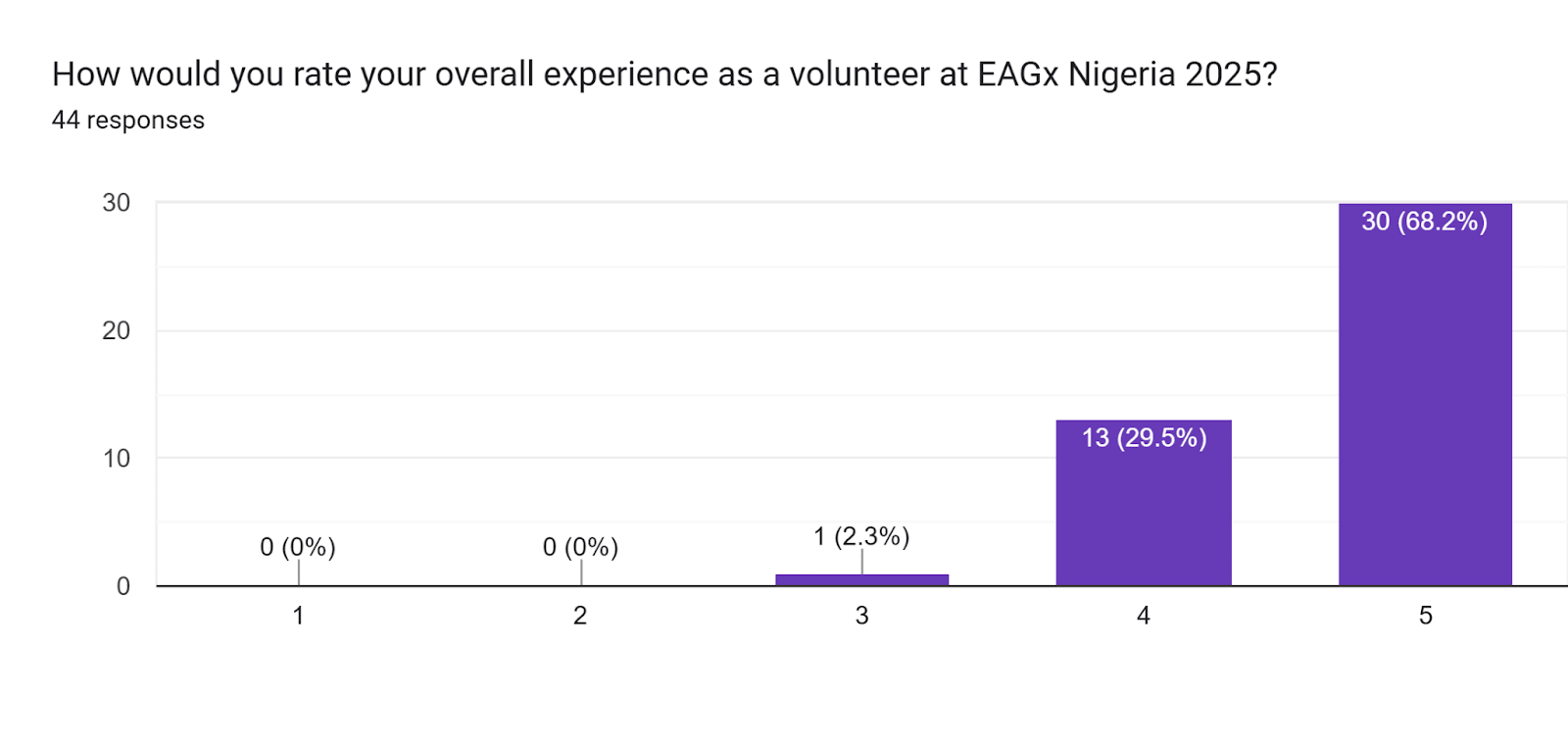
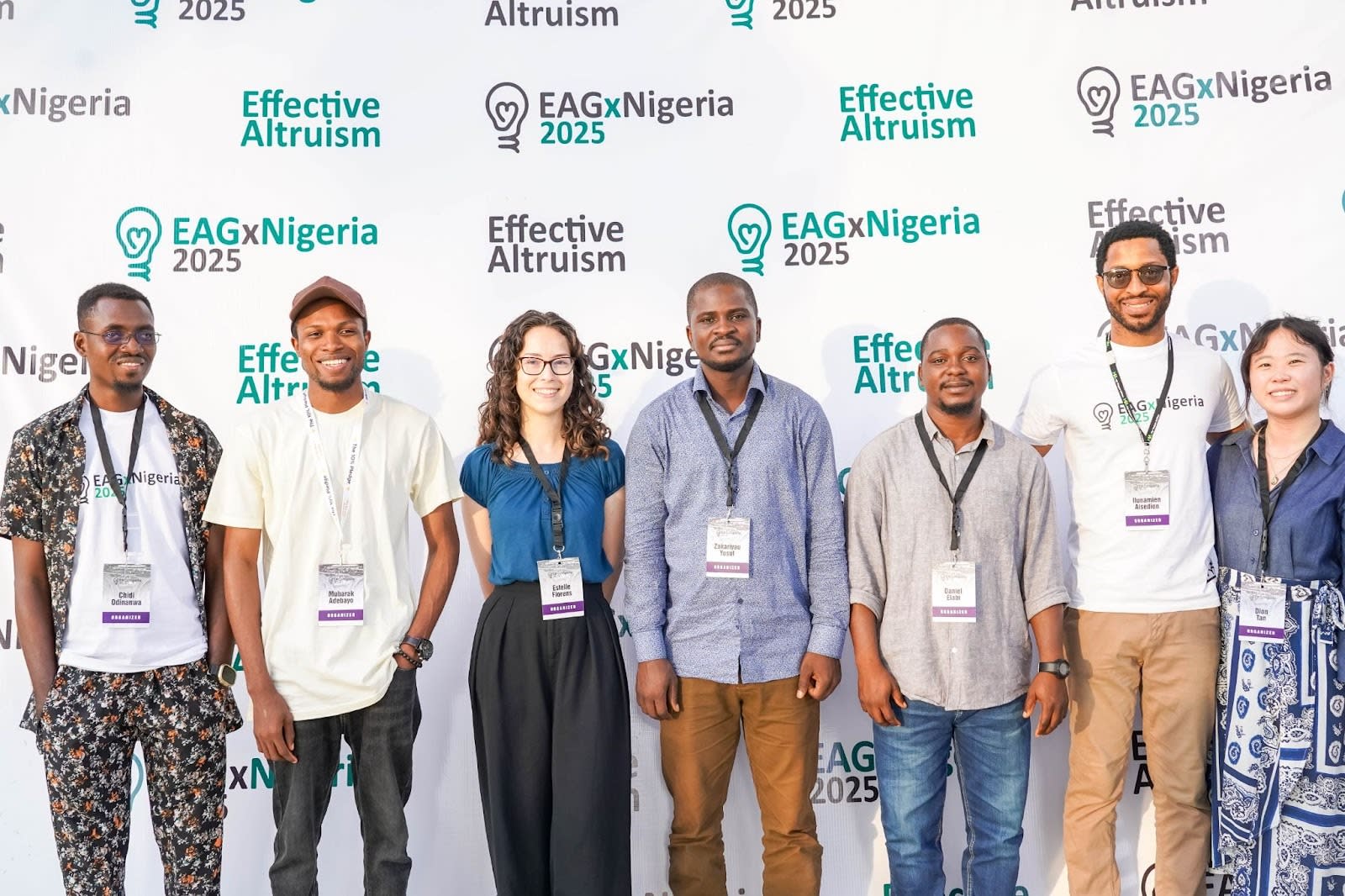
This is so exciting to see! I've been facilitating for EA Virtual Programs for years, and have anecdotally seen a significant uptick in participants from the African continent in the last year+. I'm very excited to see the growth of EA values & community in new regions. Thank you for writing this retrospective! (also, 11 valuable new connections per participant seems quite good, I think? So well done on that!)
Executive summary: This retrospective details how EAGxNigeria 2025—Africa’s largest Effective Altruism conference to date—successfully convened nearly 300 attendees from 15+ countries to strengthen EA community growth and regional engagement, while highlighting logistical, technical, and volunteer coordination lessons for future events.
Key points:
This comment was auto-generated by the EA Forum Team. Feel free to point out issues with this summary by replying to the comment, and contact us if you have feedback.
Huge thanks to the EAGxNigeria team! This retrospective captures the event perfectly. Attending and volunteering as a speaker liaison was fantastic. Yes, there's always room to grow, but the organizers did an amazing job bringing together so many passionate, impact-driven people. The energy was incredible, from the talks and 1-1s right down to the chats over meals.
I definitely left buzzing with ideas. As an organiser for the EA Ahmadu Bello University Group, the 1-1s with other experienced organisers gave me practical tips for my group. And personally? Those conversations really pushed me. I've decided to dive into learning technical AI, aiming to work on AI Safety more effectively.
Since collaboration was such a big theme, I'm putting this out there: I'm looking for connections, advice, or info on opportunities (like grants or sponsorships) to help with this AI Safety journey. If you have any leads or want to chat about it, please reach out! You can email me at israelanuoluwaposimi955@gmail.com or connect on LinkedIn.
So glad I came, and really looking forward to more events from EA Nigeria and the wider EA community. Thanks again!
Great job on the event! I'm happy, both from a personal and impact-focused perspective, to see successful community building being done in Africa :)